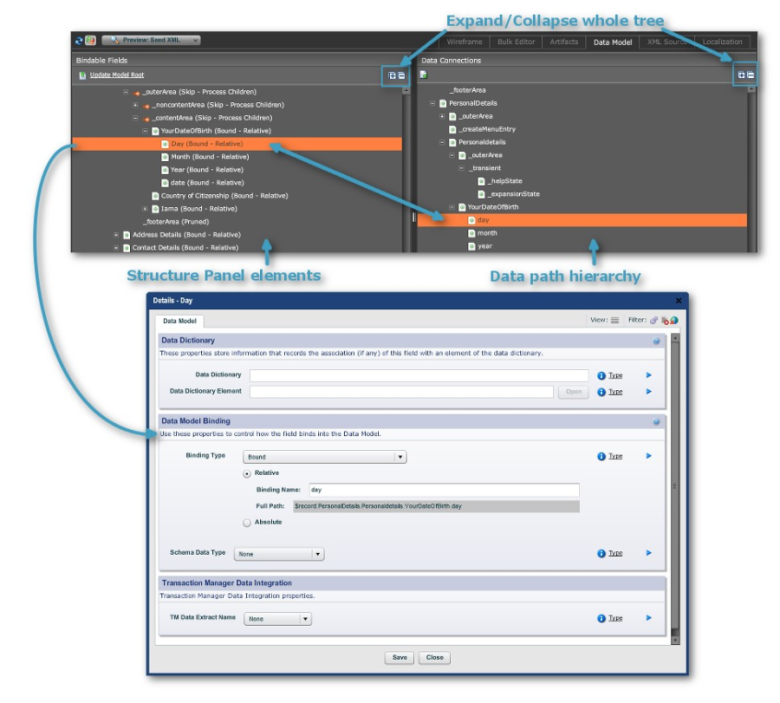Form Designer Advanced Features
Composer This topic is related to Transact Composer. | Form Builder | v4.3 & Higher This feature is related to v4.3 and higher.
Overview
Besides the Wireframe tab of the Form Designer, there are:
The Bulk Editor tab The Artifacts tab The Data Model tab The XML Source tab
The Localization tab
These do not provide further functionality than that already given in the
Edit Properties dialogs and panels, but instead organize the parameter and
settings of the form into tables. Some of these allow parameter settings to
be changed and can be more convenient than going in and out of numerous Edit
Properties dialogs for the fields and nodes on the form. The tabs provide an
alternative and more comprehensive view of the parameter settings of the
form than the atomic and fragmented glimpses afforded by going through the
properties of a large number of individual form widgets.
There are at present some limitations: you cannot now alter the settings for
the same type of parameter on a number of form elements. But, the ability to
be able to survey the setting on, for example, all the Composer scripts
within the form is a vary valuable facility.
Bulk Editor
In the Rules Property Set listing, you can select "Script Based"
under Visibility, Edibility and so on, and then use the "Edit"
button that appears in the row to bring up the
"Script Editor", a very convenient way to access this dialog.
Property Sets
The form's parameters are arranged in Property Sets, which belong to the
Organization. You edit, and create
new, property sets in "Workspace -> <Organization> ->
Administration tab -> Property Set tab".
This the only place in the UI that you can create a new set. However, you
cannot at present configure the new set. You must configure it in the Bulk
Editor of one of the forms in the Organization, using the Edit Property Set
dialog from the "Configure" link at the top of the Bulk Editor
page. Here you select a property from the Property List (which just like
Widget Palette in the Form Editor) and then double-click on the Property you
want in the Property Set. The property then appears in Property list in the
lower half of the Edit Properties Set dialog. You can change the wording of
the heading of the resulting Property Set column in the Bulk Editor
Artifacts Tab
This lists, and allows you to download, files associated with the form. Here
is a partial list of the files:
<form name>.xls
A spreadsheet of all the form elements and their properties, including the
Nuts & Botls
<form name>.xml
The form definition in XML.
<form name>_info.properties
A text file giving listing the creation date, time and time zone, and the
previewtechnology.
Data Model Tab
The left-hand panel gives the various bindings (bound, unbound, relative,
absolute) of the fields in the structure; the right shows the field's
position in the data hierarchy. Select a field in one of these two panels
and it will be selected in the other panel.
Double-clicking on a field in the left-hand panel will also bring up a
dialog with the Data-related panels to be found in the "Edit
Properties" dialog, though conveniently grouped into a "Data Model
tab" created for this part of the User Interface.
The hierarchy depicted in the right-hand panel is the data hierarchy. In
Composer, the data hierarchy is for the most part a reflection of the form's
structure. This means that the data structure of the field bindings within a
block is, for better or for worse, similar to the way the fields relate
according to layout and block groupings. It is beyond the scope of this
document to show how to change these relationships without altering the
layout structure of the form itself.
XML Source Tab
This tab is an editable display of the XML definition file of the form. You
can (provided you the rights to do so) save you changes, or you can rollback
the last edits you have made to the code. Only do this if you are sure of
what you doing; otherwise you can do serious damage to the form.
The XML frquently has Character Data ("CDATA") blocks, which are
code that is passed straight through the
XML parser without it reading the block (which it would not understand in
any case). CDATA here is used, in the main, to pass JavaScript fragments.
Localization Tab
This is explained
elsewhere in theguide.
Transact Composer User Guide and ReferenceAccess & Security


